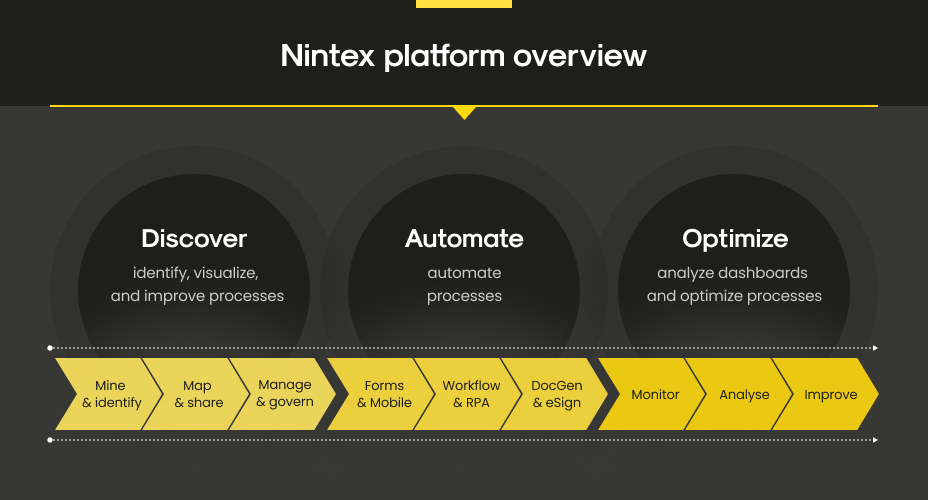Efficiency is everything. From HR management to business process automation, companies are under pressure to eliminate manual processes and digitize workflows. That’s where Nintex comes in, a no-code/low-code platform trusted by thousands of organizations to automate, optimize, and manage their operations.
But here’s the catch: to get real value from Nintex, you need more than drag-and-drop workflows. You need strategy, integration, and customization that fits your business like a glove. At the same time, while Nintex has served many companies well, today’s automation demands are evolving fast, and relying on older tools without adaptation can leave gaps in performance, flexibility, and future-readiness. In this article, you’ll discover:
- Why workflow automation is more critical than ever in today’s AI-driven business landscape
- What Nintex does well and where it’s starting to show its age
- The true cost of sticking with legacy tools versus upgrading to future-ready platforms
- How modern alternatives like Power Platform, skybow Studio, and others stack up
- What to expect during a workflow migration, and how to avoid common pitfalls
- Real-world examples of successful migrations led by the Mitrix team
- How Mitrix helps companies replace, modernize, and scale their business processes with smarter automation strategies
What is Nintex?
Nintex is a workflow automation platform that allows organizations to automate business processes using visual tools, and no coding skills are required. Whether it’s generating documents, handling employee onboarding, processing service requests, or managing contracts, Nintex helps teams work faster and smarter.
Nintex’s key features include:
- Workflow automation across departments
- Digital forms for data collection and approvals
- Document generation and e-signature integration
- Process mapping via Promapp
- Enterprise integrations with SharePoint, Office 365, Salesforce, SAP, and more

Nintex platform overview
Besides, the company has recently rolled out a new wave of AI-powered enhancements aimed at simplifying how businesses document, manage, and automate their workflows.
Real-world use cases
Okay, now let’s bring it to life. Here’s what companies are using Nintex for today:
- Onboarding new employees. Automate forms, IT access, equipment provisioning, and welcome emails.
- Sales contract approvals. Auto-generate contracts from templates, route them to legal and collect e-signatures.
- Compliance workflows. Ensure documentation is reviewed, approved, and stored with full traceability.
- Service request handling. Route requests to the right team, track resolution times and escalate when needed.
Why companies are reconsidering Nintex
While Nintex has served many organizations well, several challenges are prompting companies to explore other options:
- High licensing costs. As workflows scale, licensing fees can become prohibitively expensive.
- Limited flexibility. Customization is often constrained compared to modern, open, or low-code platforms.
- Platform lock-in. Heavy reliance on proprietary features can make migration and integration with other systems difficult.
- Performance issues. Some users report performance bottlenecks and scalability concerns, particularly with complex workflows.
These drawbacks have led organizations to re-evaluate whether Nintex aligns with their evolving digital transformation goals.
But what’s next?
Nintex On‑Prem (Workflow for Office 365) reaches end of support in December 2025, with underlying SharePoint workflows deprecated by April 2026. While Nintex has long served as a powerful automation tool, many enterprises are now transitioning to more flexible and future-ready platforms like Microsoft Power Platform.
These newer ecosystems offer deeper integration with modern cloud services, more advanced AI-driven capabilities, and a stronger developer community, making them better suited for complex, evolving business needs. For organizations still using Nintex, the key is to modernize their workflows strategically, either by enhancing what’s already in place or by gradually migrating to platforms that can scale with their digital transformation goals.
Exploring Nintex alternatives: what are your options?
In regard to the news above, organizations must weigh their next move carefully. Rebuilding workflows from scratch in Nintex Automation Cloud isn’t just costly: it often means facing a 4–5x increase in licensing fees. The good news? You’re not stuck. Several viable, cost-effective alternatives can help you modernize your workflow automation without losing momentum (or your budget).
skybow Studio
A SharePoint-native, low-code platform built for teams that want to stay within Microsoft 365 without the overhead of cloud migration. skybow allows direct reuse of existing forms and workflows, drastically reducing the time and cost of transition. It’s ideal for those looking to retain familiar environments while gaining modern flexibility.
Power Automate (Microsoft)
If you’re already deeply invested in the Microsoft ecosystem, Power Automate is a natural choice. It offers tight integration with Microsoft 365 and Azure services. However, complex workflows may require premium connectors or custom development, which can add hidden costs.
FlowForma
Designed for business users, FlowForma provides no-code workflow automation with a strong focus on governance and compliance. It’s a solid option for organizations in regulated industries looking to simplify process management.
WEBCON BPS
Best suited for enterprises with complex processes, WEBCON BPS provides advanced workflow logic, real-time process monitoring, and strong scalability. It’s a full-featured platform with on-prem, cloud, or hybrid deployment options.
Ninox or Kissflow
For smaller teams or departments that don’t need enterprise-grade scale, lightweight tools like Ninox or Kissflow offer intuitive interfaces and fast onboarding, making them good short-term or departmental solutions.
How Mitrix can help
One of our projects involved a global manufacturer with over 10.000 employees and thousands of workflows running on SharePoint 2016 with Nintex. The challenge was to migrate everything to Microsoft 365 while translating complex workflows (including those using features like Nintex’s State Machine) into Power Automate without losing functionality or business continuity.
Our team tackled this head-on using a structured, multi-phase approach:
- Discovery and planning. We started with a comprehensive audit of the client’s Nintex workflows using a custom-built .NET discovery tool. This allowed us to identify, catalog, and analyze thousands of business processes across site collections with precision and speed.
- Workflow migration. Our engineers recreated each selected Nintex workflow using Microsoft Power Automate and built in functional equivalents where direct translation wasn’t possible. They have also developed intelligent workarounds for advanced use cases.
- Form modernization. Many workflows relied on legacy InfoPath forms. We modernized them using PowerApps to create responsive, user-friendly forms that integrate seamlessly with Power Platform and Microsoft 365.
- Collaboration and QA. We worked closely with site owners to validate functionality, run UAT cycles, and continuously refine based on user feedback, ensuring each process ran smoothly in its new environment.
- Deployment and ongoing support. After successful migration and validation, we helped deploy the new workflows to production and continue to support the client with performance optimization, new feature implementation, and Microsoft 365 consulting.
The result is a scalable, cloud-native automation ecosystem that streamlined operations, improved user experience, and unlocked greater agility for future innovation.
Whether you’re moving away from Nintex, struggling with aging SharePoint workflows, or simply looking to modernize your automation stack, Mitrix can help you:
- Migrate workflows from Nintex to Microsoft Power Platform
- Rebuild or enhance complex logic and automation flows
- Replace outdated forms with intuitive PowerApps solutions
- Connect systems with REST APIs and custom connectors
- Ensure compliance, traceability, and smooth user adoption
We understand that workflow migration is all about business continuity. That’s why we work side-by-side with your teams to ensure the transition is seamless, future-proof, and aligned with your goals. Let Mitrix help you say goodbye to legacy automation and hello to a smarter, more scalable way of working. Contact us today!
Summing up
Legacy workflow platforms like Nintex may have served their purpose, but staying competitive means evolving your automation strategy. Modern platforms like Microsoft Power Platform offer more flexibility, scalability, and integration potential, but getting there isn’t always straightforward.
With hands-on experience migrating complex, high-volume workflows, our team knows how to navigate the challenges and deliver real results. Whether you’re planning a full migration or just starting to explore your options, we’re here to guide you every step of the way: no guesswork, no disruption, just smarter automation.


